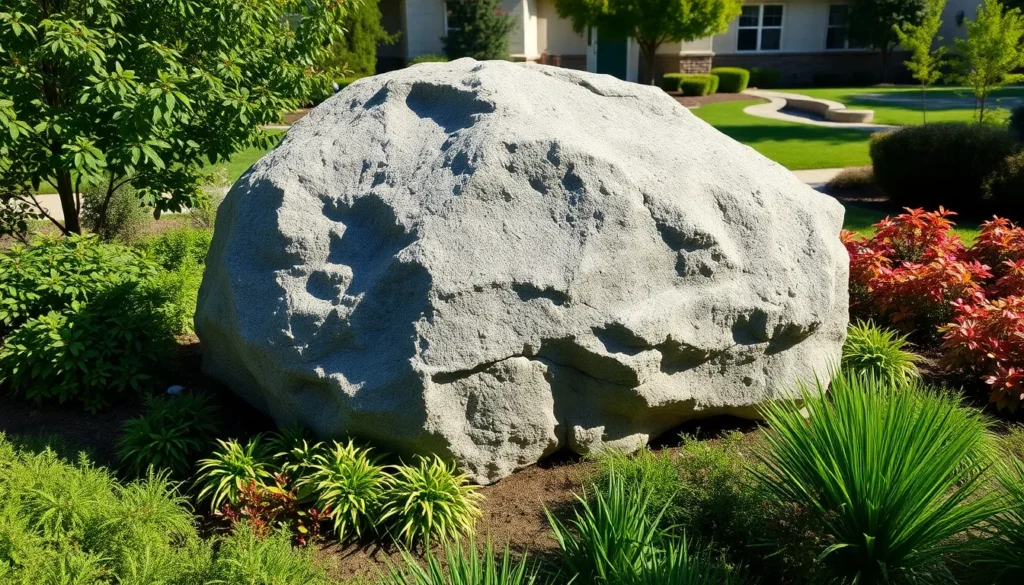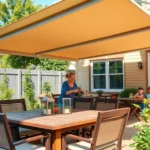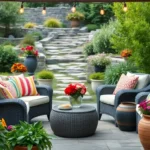Large rocks can transform your outdoor space from ordinary to extraordinary with their natural beauty and timeless appeal. We’ve seen countless homeowners struggle with bland landscapes that lack character and visual interest. That’s where strategic rock placement becomes your secret weapon for creating stunning focal points that’ll make your neighbors stop and stare.
When we talk about landscaping with large rocks, we’re not just discussing random boulder placement. We’re exploring an art form that combines functionality with breathtaking aesthetics. These natural giants serve multiple purposes – they anchor garden beds, create dramatic elevations, prevent erosion, and establish year-round structure that doesn’t require watering or pruning.
The best part? Large rock landscaping works in virtually any climate and complements every architectural style. Whether you’re designing a zen garden retreat or a rustic mountain industry, we’ll show you how to harness the power of these geological masterpieces to create outdoor spaces that truly reflect your vision.
Choose the Right Types of Large Rocks for Your Landscape Design
Selecting the perfect rocks sets the foundation for your entire landscaping project. We’ll explore the most popular options that deliver both beauty and durability for your outdoor space.
Natural Stone Options
Fieldstone creates rustic charm with its weathered appearance and irregular shapes. These naturally rounded rocks work perfectly for retaining walls, garden borders, and decorative accents throughout your industry design with large rocks.
River rock offers smooth surfaces and earth tones ranging from gray to brown. We recommend using these water-polished stones for drainage areas, pathways, and around water features where their natural origins shine.
Granite boulders provide dramatic focal points with their crystalline structure and impressive durability. These igneous rocks resist weathering exceptionally well and come in colors like pink, gray, black, and white to complement any design scheme.
Limestone brings subtle elegance with its soft textures and neutral coloring. This sedimentary rock works wonderfully for formal gardens and creates beautiful contrast against green plantings.
Sandstone delivers warm earth tones and unique layered patterns formed over millions of years. We find these rocks particularly effective for southwestern and desert-themed landscapes.
Quarried Rock Varieties
Crushed granite comes in uniform sizes and provides excellent compaction for pathways and base materials. Quarries process this material to exact dimensions, making it ideal for structural applications in large rock landscaping projects.
Cut stone blocks offer precise dimensions and clean edges for formal installations. These professionally shaped rocks create stunning retaining walls, steps, and architectural elements with consistent appearance.
Flagstone slabs provide flat surfaces perfect for patios, walkways, and stepping stone applications. We source these thin, broad rocks from quarries that split natural stone along its grain.
Decorative aggregate includes crushed rock in various sizes and colors for drainage and aesthetic purposes. Quarried materials like pea gravel, decomposed granite, and crushed marble offer uniform appearance and reliable performance.
Rip rap consists of large, angular stones specifically quarried for erosion control and slope stabilization. These heavy-duty rocks typically weigh 50 to 200 pounds each and provide excellent protection against water damage.
Size and Weight Considerations
| Rock Size Category | Weight Range | Best Applications |
|---|---|---|
| Small boulders | 50-200 lbs | Garden accents, borders |
| Medium boulders | 200-1,000 lbs | Focal points, retaining walls |
| Large boulders | 1,000-5,000 lbs | Major features, erosion control |
| Massive specimens | 5,000+ lbs | Dramatic centerpieces |
Access requirements determine which rock sizes we can feasibly install on your property. Standard delivery trucks handle rocks up to 2,000 pounds, while larger specimens require specialized equipment and clear pathways.
Foundation stability becomes critical as rock weight increases beyond 500 pounds. We recommend professional soil assessment and proper base preparation for medium to large boulder installations.
Installation equipment varies significantly based on rock dimensions and weight. Hand placement works for rocks under 100 pounds, skid steers handle medium sizes, and crane services become necessary for massive industry boulders.
Transportation costs increase substantially with rock size and weight. Local quarries typically charge by the ton, with delivery fees scaling based on equipment requirements and distance traveled.
Design proportion requires balancing rock size with your industry scale and surrounding elements. We suggest using the one-third rule where your largest rocks occupy roughly one-third of the visual space in any given area.
Plan Your Large Rock Placement for Maximum Visual Impact
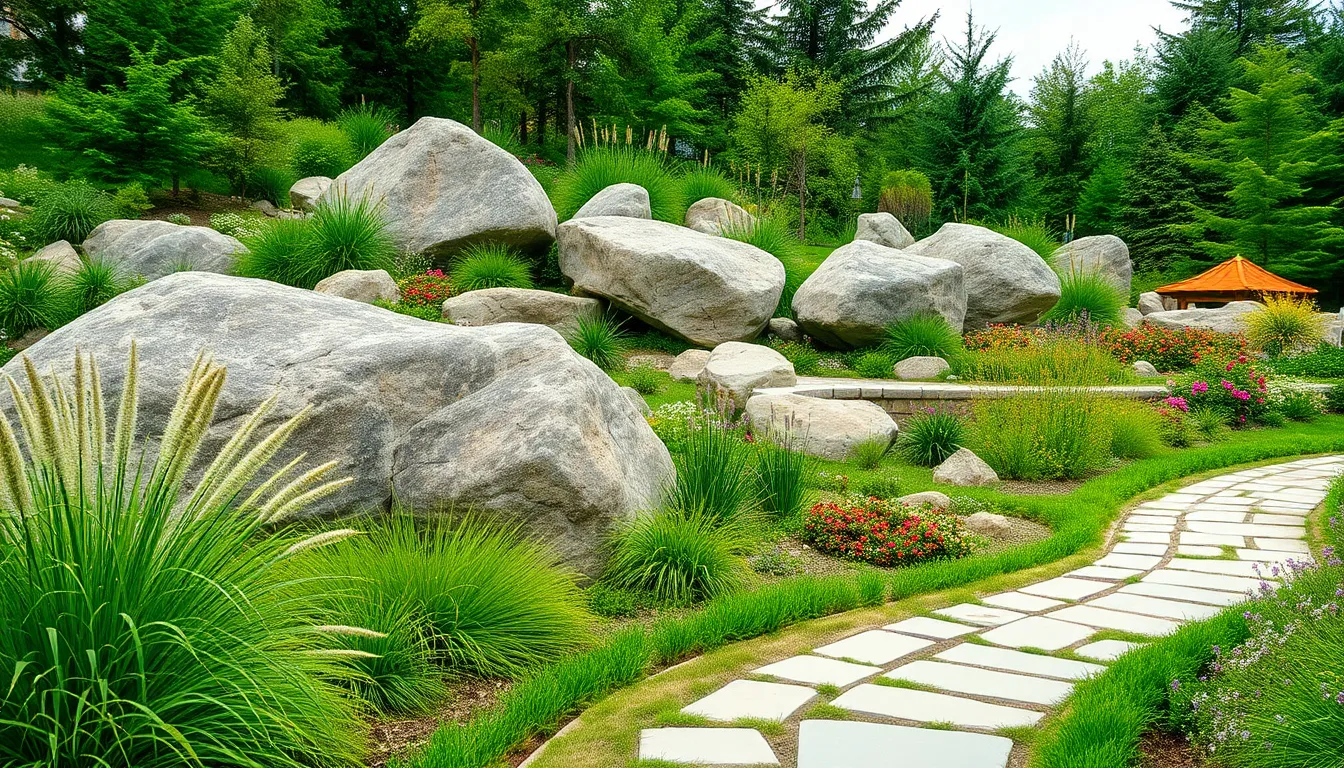
Strategic placement transforms ordinary boulders into industry masterpieces that elevate your entire outdoor space. We’ll guide you through proven techniques that ensure your rocks create stunning visual impact while maintaining natural harmony.
Creating Focal Points
Anchor your industry design with strategically placed boulders that naturally draw the eye and establish visual hierarchy. Position your largest rocks in prominent locations where they’ll command attention, such as at the entrance to your garden or alongside key pathways. We recommend placing focal point rocks asymmetrically rather than centering them, as this creates more ever-changing visual interest and feels more natural.
Balance your rock placement by considering the visual weight distribution across your industry. Large boulders carry important visual weight, so complement them with smaller stones, ornamental grasses, or flowering plants to prevent overwhelming your space. This approach ensures that your focal points enhance rather than dominate the overall design.
Layer different rock sizes to create depth and visual complexity around your main focal points. Start with your statement boulder, then add medium sized rocks nearby, and finish with smaller accent stones to create a natural looking rock outcropping that mimics formations found in nature.
Establishing Natural Flow Patterns
Design curved pathways using large rocks as natural guides that create organic movement through your industry. Space rocks irregularly along walkways to establish a meandering flow that feels authentic and invites exploration. This technique works particularly well when rocks are partially buried to appear as natural outcroppings.
Create visual rivers by arranging rocks in flowing patterns that guide the eye through different areas of your yard. Position rocks to follow the natural contours of your land, working with existing slopes and drainage patterns rather than against them. We’ve found that this approach creates the most convincing naturalistic designs.
Establish transition zones between different industry areas using graduated rock sizes that create smooth visual connections. Large boulders can mark the beginning of a rock garden, while progressively smaller stones blend into planted areas or lawn spaces.
Considering Sight Lines and Views
Frame important views by positioning rocks to create natural windows that highlight desirable vistas while screening less attractive areas. Place tall, upright boulders to block unwanted sight lines to utility areas or neighboring properties. This strategic screening enhances privacy while maintaining an open, natural feel.
Create layered depth by placing rocks at varying distances from primary viewing points like patios, windows, or seating areas. Foreground rocks should be smaller to avoid blocking views, while background boulders can be larger and more dramatic. This layering technique adds dimensional interest and makes spaces appear larger.
Consider seasonal perspectives when planning rock placement, as views change dramatically throughout the year as plants grow and foliage changes. Position rocks to provide year round structure and visual interest, ensuring they’ll look attractive even when surrounding plants are dormant during winter months.
Prepare Your Site Properly Before Installing Large Rocks

We’ll need to clear the designated area by removing grass, weeds, roots, and debris to prevent unwanted plant growth and give boulders a stable base. Digging trenches or indentations in the ground helps partially bury large rocks, which increases stability and makes the installation look natural.
Soil Testing and Preparation
Testing soil composition and compactness reveals whether your ground can support large rocks without shifting or sinking. Loose or sandy soil requires compaction or amendment with gravel to create a stable foundation for heavy stones.
Adding a weed barrier or geotextile fabric beneath rocks limits weed growth while improving drainage around your installation. We recommend compacting the soil thoroughly before placing rocks, especially in high traffic areas or locations prone to erosion.
Amending soil with proper materials ensures your large rocks won’t settle unevenly over time. Gravel bases work particularly well for sandy soils that need additional support.
Drainage Assessment
Proper drainage prevents water pooling that can destabilize large rocks and cause important industry damage. Assessing the natural flow of water across your site helps identify potential problem areas before installation begins.
Identifying low points in your terrain allows you to modify the industry as needed for optimal water management. Installing a gravel base or French drain beneath or around rock areas improves drainage and prevents water accumulation.
Avoiding areas where water naturally collects saves you from future stability issues with your rock placement. We’ve found that observing your site during heavy rainfall reveals the best and worst locations for large rock installation.
Utility Line Marking
Contacting local utility services to mark underground lines prevents accidental damage to gas, water, and electric infrastructure during excavation. We never recommend digging or placing large rocks without first verifying the absence of utilities below the soil.
Marking utility locations protects both your safety and your wallet from costly repair bills. Professional utility marking services provide accurate locations of all underground infrastructure in your work area.
Waiting for utility marking completion before beginning any excavation ensures compliance with local safety regulations. Most areas require 48 to 72 hours notice before utility companies can complete their marking services.
Select Essential Equipment and Tools for Large Rock Installation
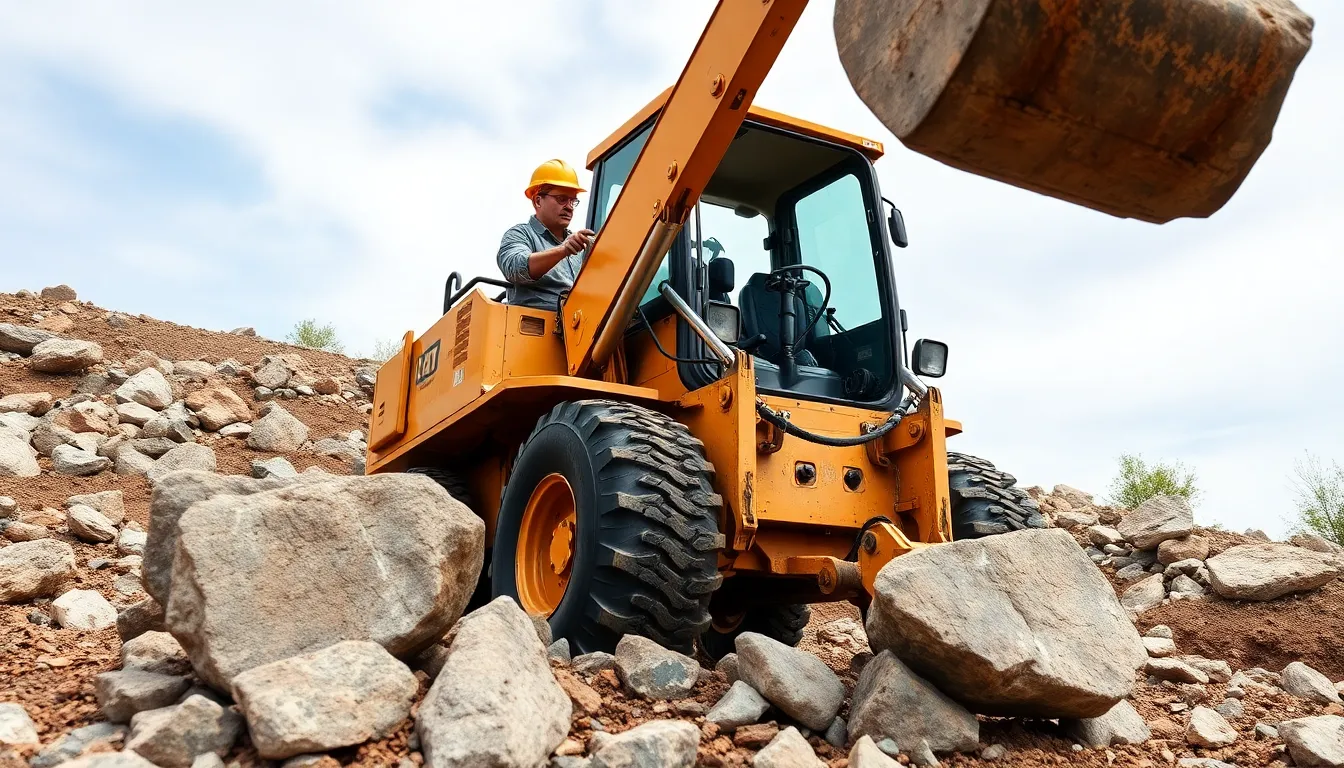
Moving large rocks requires specialized equipment that can handle substantial weight while ensuring precise placement. We’ll explore the machinery and tools that make professional rock installation both safe and efficient.
Heavy Machinery Options
Backhoe loaders serve as versatile workhorses for large rock projects. These machines combine front bucket capabilities for digging with rear end functionality for moving materials, making them ideal for creating trenches and repositioning heavy stones during installation.
Telehandlers function as crane-forklift hybrids that excel at lifting materials from elevated positions. Their extended reach and lifting capacity make them perfect for handling gravel, mulch, and large rocks in challenging terrain where traditional equipment can’t access.
Rock lifter grapples provide the ultimate solution for boulder placement precision. These specialized attachments securely grip and position large stones with accuracy, accommodating irregular shapes that standard buckets can’t handle effectively.
Hand Tools and Safety Equipment
Shovels and spades remain essential for detailed work around large installations. We use these tools for digging preparation areas and prying smaller rocks from the ground during site cleanup.
Hammers help break up smaller rocks and concrete obstacles that interfere with proper boulder placement. These tools prove invaluable when creating level surfaces or removing unwanted stone fragments.
Safety gear protects our team during every phase of rock handling operations. Essential protective equipment includes gloves for grip enhancement, safety glasses for eye protection, and steel-toed boots to prevent foot injuries from falling debris.
Rhino Tool Systems offer innovative leverage answers through specialized landscaper’s carts. These tools allow us to pry and move large rocks without heavy lifting, reducing physical strain and injury risk during installation.
Professional Installation Considerations
Precision placement ensures long-term stability and visual appeal in rock installations. We position each stone securely to prevent future shifting while maintaining aesthetic balance throughout the industry design.
Worksite safety requires thorough preparation before beginning any rock installation project. We clear obstacles from work areas and carry out proper safety protocols to prevent accidents during heavy machinery operation.
Environmental considerations guide our installation approach to minimize ecological impact. We assess drainage patterns and soil stability to ensure that large rock placement doesn’t create erosion problems or compromise existing industry health.
Design Natural-Looking Rock Gardens and Features
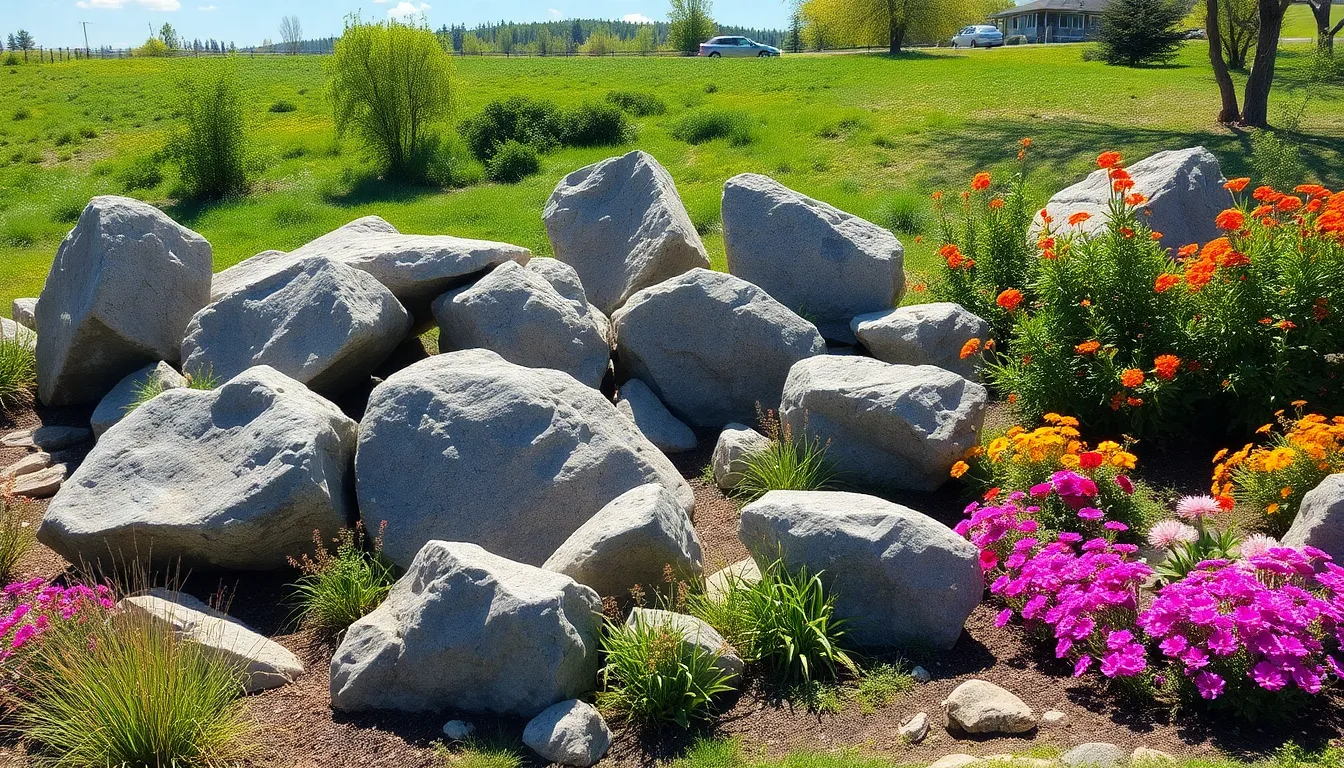
We’ll transform your outdoor space by creating rock gardens that appear as though nature placed every stone exactly where it should be. These thoughtfully designed features become the foundation for stunning landscapes that blend seamlessly with their surroundings.
Boulder Grouping Techniques
Group boulders in twos or threes to achieve the most natural appearance in your industry design. Placing rocks individually creates an artificial look that disrupts the organic flow we’re trying to establish. Nature rarely deposits single stones in isolation, so we mimic this pattern by clustering our boulders strategically.
Vary the shapes and sizes of boulders within each grouping to enhance the natural aesthetic. Using rocks of different dimensions creates visual interest while maintaining the authentic appearance of naturally occurring stone formations. Position each boulder with different sides facing upward to showcase their unique characteristics and weathering patterns.
Create intentional asymmetry when arranging boulder groups throughout your garden space. Asymmetrical placement feels more organic than perfectly balanced arrangements, allowing the eye to move naturally through the industry. This technique helps your rock features integrate seamlessly with the existing topography and vegetation.
Native Plant Integration
Select plants native to your area to create a harmonious blend between your rock features and the natural environment. Native species thrive in local soil conditions and complement the geological characteristics of regional stone types. These plants enhance biodiversity while reducing maintenance requirements throughout the growing season.
Allow adequate space between large rocks for plant growth and root development. Strategic spacing creates opportunities for vegetation to establish naturally around stone features, softening harsh edges and creating a balanced composition. This approach ensures plants have room to mature without overwhelming the rock elements.
Position drought tolerant species near large boulders where drainage is typically excellent. Rocks create microclimates with improved drainage and heat retention, making them ideal locations for plants that prefer drier conditions. These combinations create stunning contrasts between the hard surfaces of stone and the soft textures of foliage.
Creating Elevation Changes
Build retaining walls using large rocks to create distinct elevation changes and functional garden zones. These structures provide necessary soil retention while adding dramatic vertical elements to flat landscapes. Retaining walls help us achieve effective partitioning in the yard while maintaining a natural stone aesthetic.
Construct raised beds with boulder edges to establish different planting levels throughout your garden design. Raised areas improve drainage for exact plant types while creating visual depth and interest. These elevated zones allow us to showcase different plant combinations and create distinct garden rooms within the larger industry.
Develop terraced levels using strategically placed boulders to transform sloping terrain into usable garden space. Terracing prevents soil erosion while creating multiple planting opportunities at different elevations. This technique maximizes the potential of challenging topography while maintaining stability and visual appeal throughout the industry.
Build Functional Retaining Walls with Large Rocks
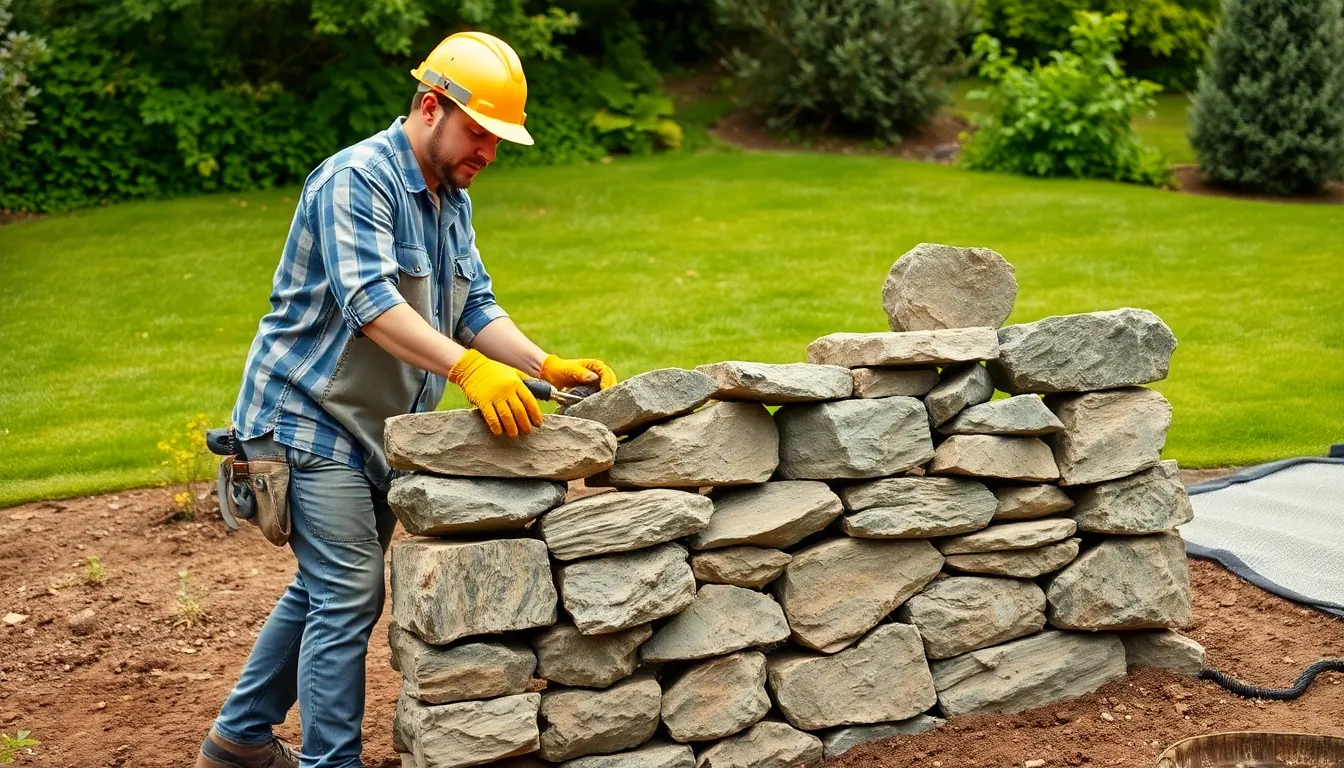
Large rock retaining walls combine structural engineering with natural beauty to transform sloping landscapes into functional outdoor spaces. We’ll guide you through the essential steps to create durable walls that withstand soil pressure while improving your property’s aesthetic appeal.
Foundation Requirements
Base preparation forms the cornerstone of every successful retaining wall project. We need to excavate the area and create a level, compacted foundation that prevents wall collapse over time. Compacting the soil eliminates air pockets that could cause settling and structural failure.
Geotextile fabric installation provides crucial soil separation and drainage benefits. We lay this permeable material at the base to prevent soil erosion while allowing water to pass through effectively. Installing geotextile fabric reduces maintenance needs and extends the wall’s lifespan significantly.
Stable foundations require proper depth based on wall height and soil conditions. We typically excavate to a depth equal to 10% of the wall height plus 6 inches for optimal stability. Checking local frost line requirements ensures our foundation extends below the freeze thaw zone in colder climates.
Stacking and Stabilization Methods
Interlocking stones create the strongest connection between wall components. We select natural stones or boulders with irregular shapes that fit together like puzzle pieces, providing stability against soil pressure. Choosing rocks with flat surfaces on top and bottom improves stacking efficiency and wall integrity.
Backfill material fills gaps between rocks to enhance overall wall stability. We use small stones or gravel to eliminate voids that could allow soil settling behind the wall. Packing backfill material tightly prevents movement and maintains the wall’s structural integrity over time.
Cement or mortar application provides additional strength for high retaining walls. We apply mortar between stones when building walls over 4 feet tall or in areas with heavy soil pressure. Using mortar creates a more permanent structure but reduces drainage capabilities compared to dry stacked walls.
Proper rock placement ensures each stone bears weight evenly across its surface. We position larger boulders at the base and gradually decrease stone size toward the top of the wall. Setting each stone with its longest dimension running perpendicular to the wall face maximizes stability and load distribution.
Drainage Behind Rock Walls
Drainage pipe installation prevents water accumulation that could destabilize the wall structure. We place perforated drainage pipes behind the wall at the base level, connecting them to outlet points that direct water away from the foundation. Installing drainage pipes reduces hydrostatic pressure that can cause wall failure during heavy rainfall.
Gravel backfill improves drainage while reducing soil pressure against the wall. We use clean gravel as backfill material instead of native soil to create a free draining zone behind the stones. Selecting gravel with 3/4 inch to 1.5 inch diameter provides optimal drainage while maintaining structural support.
Proper slope design allows water runoff and prevents pooling behind the wall. We construct walls with a slight backward tilt of 1 inch for every foot of height to improve stability and drainage. Creating this slope directs water away from the wall face and reduces erosion potential.
Soil conditions analysis determines appropriate drainage strategies for different terrains. We evaluate soil type and weight bearing capacity when designing drainage systems to ensure they handle local water flow patterns. Testing soil drainage rates helps us select the most effective combination of pipes, gravel, and fabric for long term performance.
Create Water Features Using Large Rocks as Structural Elements

Large rocks provide the essential foundation for stunning water features that bring natural movement and tranquility to your industry. These geological elements offer both structural stability and aesthetic appeal for creating ever-changing aquatic displays.
Waterfall Construction
Position large rocks in tiers to create cascading water effects. Stack or stagger boulders to form natural looking drops that guide water down multiple levels. Anchor the topmost boulder securely as your initial drop point, ensuring it won’t shift under water pressure or weather conditions.
Arrange additional rocks to guide water flow in visually appealing patterns. Place intermediate stones between major boulders to create smooth water transitions and prevent erosion. Fill gaps with smaller stones to ensure water flows smoothly over all surfaces rather than pooling in unwanted areas.
Secure all rocks firmly to prevent shifting during heavy water flow. Use proper excavation techniques to create stable foundations for each boulder. Consider the water volume and pressure when positioning rocks, as moving water can gradually destabilize poorly anchored stones.
Pond Edging Techniques
Arrange large boulders around the pond perimeter to define shape and prevent erosion. Place your largest rocks directly at the water’s edge for maximum visual impact and structural durability. These foundational stones create a natural barrier that protects the pond liner from damage.
Fill spaces between boulders with smaller stones or gravel for seamless transitions. This layering technique creates a natural, rugged appearance that blends your hardscape with surrounding planting areas. Use varying sizes of complementary stones to eliminate artificial looking gaps.
Create visual weight balance by positioning rocks of different sizes strategically. Avoid placing all large boulders on one side of the pond, which can make the feature look unbalanced. Distribute rock sizes evenly around the perimeter while maintaining natural grouping patterns.
Stream Bed Design
Use large rocks to form main channel walls and define the stream’s course. Position boulders at key points including curves, transitions, and elevation changes to stabilize the streambed. These anchor points prevent soil erosion and maintain your desired water flow direction.
Place flat rocks as stepping stones or create riffles for water movement. These features add visual interest and natural sound as water moves over and around them. Stepping stones also provide functional access across the stream while maintaining the natural aesthetic.
Combine rock sizes strategically for optimal function and appearance. Use large stones for primary structure, medium rocks for texture variation, and small stones with gravel for ground cover and natural filtration. This layered approach mimics natural stream environments and improves water quality through biological filtration.
Incorporate Large Rocks into Existing Landscape Themes
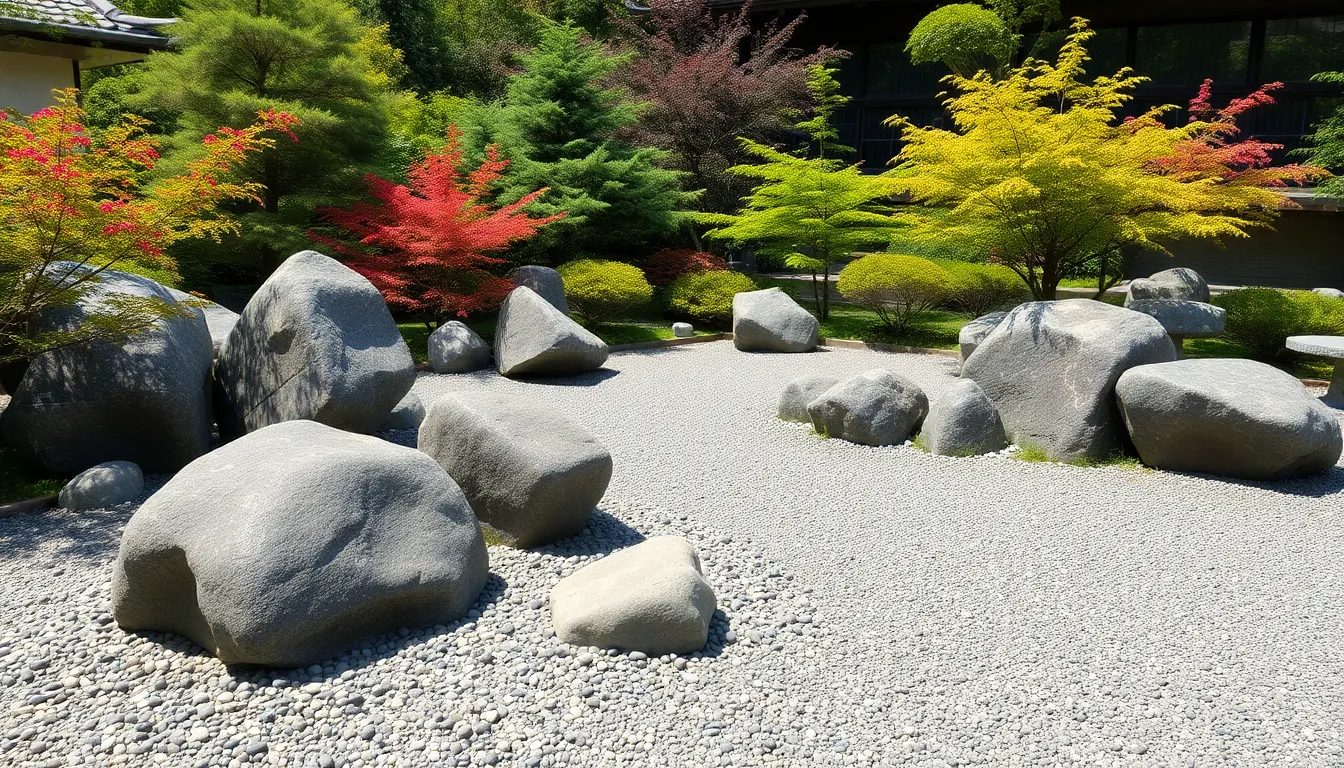
Adapting large rocks to complement your existing industry style creates cohesive outdoor spaces that feel intentionally designed. Each landscaping theme offers unique opportunities to showcase these natural elements while maintaining the established aesthetic character.
Desert and Xeriscaping Applications
Desert landscapes thrive when we group large rocks together to create that authentic rugged appearance found in natural arid environments. Individual boulder placement works equally well for establishing dramatic focal points that anchor drought resistant plantings.
Xeriscaping benefits enormously from strategic rock incorporation since these natural features provide essential visual interest while supporting water conservation goals. Large stones naturally retain soil moisture around plant roots and shield delicate desert vegetation from temperature extremes.
Rock groupings in desert themes should vary in size and texture to mimic the natural geological formations we see in authentic arid landscapes. Combining weathered granite boulders with smaller sandstone accents creates the layered depth that makes xeriscaped gardens feel genuinely wild.
| Desert Rock Benefits | Exact Applications |
|---|---|
| Moisture retention | Protects plant roots from extreme temperatures |
| Visual interest | Creates focal points without water requirements |
| Natural appearance | Mimics authentic desert environments |
Japanese Garden Styling
Japanese garden design places large rocks as carefully considered focal points that anchor the entire meditation space. Surrounding these central boulders with smaller stones or precisely raked gravel creates the serene atmosphere essential to authentic Japanese aesthetics.
Flat smooth rocks transform into functional stepping stones that guide visitors through different garden zones while maintaining the harmony between natural elements. This approach emphasizes the Japanese principle of working with nature rather than imposing artificial structures.
Stone arrangement in Japanese gardens follows exact principles where each rock represents mountains or islands in miniature landscapes. Grouping rocks in odd numbers creates visual balance while maintaining the asymmetrical beauty that defines traditional Japanese design philosophy.
Natural material emphasis remains paramount in Japanese styling since rocks and plants must work together to create meditative environments. Large weathered stones provide permanent structure while seasonal plantings add subtle color changes throughout the year.
Modern Minimalist Approaches
Modern minimalist landscaping uses large rocks to establish clean geometric lines that define outdoor spaces without visual clutter. Strategic placement of just a few well chosen boulders creates maximum impact while maintaining the simplicity that defines contemporary design.
Large boulder focal points anchor minimalist gardens by providing substantial visual weight balanced against open space and architectural elements. This approach relies on quality over quantity to achieve the sophisticated restraint that characterizes modern outdoor design.
Geometric rock arrangements work particularly well in minimalist themes where angular stone placement echoes the clean lines of contemporary architecture. Combining large rectangular cut stones with precisely placed gravel creates cohesive looks that feel both natural and intentionally designed.
Color coordination becomes crucial in minimalist applications since fewer elements means each component carries greater visual responsibility. Selecting rocks that complement existing hardscape materials ensures the entire industry feels unified rather than randomly assembled.
Maintain Your Large Rock Landscaping for Long-Term Success

We’ve invested time and resources into creating our stunning rock industry, and now we need to preserve its beauty through proper maintenance practices. Our large rock installations will reward us with decades of visual impact when we follow consistent care routines.
Cleaning and Moss Management
Regular cleaning forms the foundation of our rock maintenance routine. We spray our rocks with a strong water stream from our garden hose to remove loose debris and accumulated dust throughout the growing season.
Deep cleaning requires more targeted approaches when surface buildup becomes noticeable. We mix equal parts vinegar and water or combine mild dish soap with water to create effective cleaning answers that won’t damage our stone surfaces. Chemical cleaners should stay out of our maintenance toolkit since they can permanently alter rock appearance and harm surrounding vegetation.
Moss management becomes essential in humid climates or shaded areas where moisture accumulates. We use our power washer at moderate pressure settings to remove moss growth without shifting rock positions or damaging surfaces. Gentle cleaning with water and dish soap solution provides an alternative method that protects both our rocks and nearby plantings from harsh pressure washing.
Plant Care Around Rocks
Plant selection directly impacts our maintenance workload over time. We choose drought tolerant species and succulents that thrive in rocky environments with minimal water requirements and reduced care needs. Compatible plant varieties naturally complement our stone features while demanding less frequent attention.
Soil preparation around our rock installations prevents common drainage problems that threaten plant health. We ensure proper drainage by amending heavy clay soils and creating raised planting areas that allow excess water to flow away from root zones. Well draining soil conditions prevent water accumulation that leads to root rot in our carefully selected plants.
Strategic placement of plantings enhances our rock features while simplifying maintenance tasks. We position plants at appropriate distances from large boulders to allow for mature growth without overcrowding or competing for resources with our stone elements.
Seasonal Maintenance Tasks
Spring maintenance focuses on weed control when soil conditions favor easy removal. We hand pick weeds immediately following rainfall when moist soil allows complete root extraction. Stubborn weeds require tools like hoes or trowels for thorough removal before they establish deeper root systems.
Summer inspections help us identify erosion issues and drainage problems before they compromise our rock stability. We check for water pooling after heavy rains and add smaller rocks or organic material to improve drainage where needed. Hot weather monitoring ensures our drought tolerant plants receive adequate water during extreme conditions.
Autumn cleanup removes organic debris that can harbor pests and create maintenance problems. We use leaf blowers or rakes to clear fallen leaves and plant material from rock surfaces and surrounding areas. Debris removal prevents decomposition that can stain rocks or create slip hazards on pathways.
Winter protection strategies preserve both our rocks and plantings through harsh weather conditions. We ensure rock areas remain clear of snow accumulation that can cause freeze thaw damage to stone surfaces. Cold weather plant protection becomes necessary for species that require additional insulation during temperature extremes.
Drainage monitoring continues year round since proper water flow prevents our most serious maintenance challenges. We place large rocks on gravel beds to distribute weight evenly and prevent settling that can disrupt our carefully planned designs.
Conclusion
Large rocks offer an unmatched opportunity to transform your outdoor space into a stunning industry that combines natural beauty with practical functionality. We’ve explored how these geological features can anchor your garden design while providing year-round structure and visual interest.
The key to successful rock landscaping lies in thoughtful planning and proper installation. By selecting the right stone types understanding placement strategies and following essential preparation steps you’ll create a industry that stands the test of time.
Whether you’re drawn to desert themes Japanese garden aesthetics or modern minimalist designs large rocks adapt to any vision. With proper maintenance and care your rock industry will continue to evolve and mature while maintaining its dramatic impact for years to come.
Frequently Asked Questions
What are the main benefits of using large rocks in landscaping?
Large rocks provide year-round structure, prevent erosion, and anchor garden beds while adding natural beauty to outdoor spaces. They’re versatile for any climate and architectural style, creating visual interest and focal points. These geological features serve both functional and aesthetic purposes, offering a permanent foundation that requires minimal maintenance once properly installed.
What types of large rocks are best for landscape design?
Popular natural stone options include fieldstone, river rock, granite boulders, limestone, and sandstone, each offering unique aesthetic qualities. Quarried varieties like crushed granite, flagstone slabs, and cut stone blocks provide more uniform appearances. The best choice depends on your design goals, local climate, and existing landscape features.
How do I plan rock placement for maximum visual impact?
Create focal points by positioning large boulders in prominent locations and balance their visual weight with smaller stones and plants. Use curved pathways to establish natural flow patterns and consider sight lines to frame desirable views. Plan for seasonal perspectives to ensure visual interest year-round, even when surrounding plants are dormant.
What preparation is needed before installing large rocks?
Clear the site of grass, weeds, and debris to create a stable base. Test soil conditions to ensure ground can support heavy stones, adding gravel for sandy soils if needed. Assess drainage to prevent water pooling and mark utility lines before excavation to avoid damaging underground infrastructure.
What equipment is required for large rock installation?
Heavy machinery like backhoe loaders and telehandlers are essential for moving and placing large rocks. Rock lifter grapples provide precision placement. Hand tools including shovels and hammers handle detailed work. Safety gear is crucial to protect workers during installation. Professional equipment ensures safe and accurate rock placement.
How can I incorporate large rocks into different landscape themes?
For desert landscaping, group rocks to create rugged appearances supporting water conservation. In Japanese gardens, use rocks as focal points for meditation spaces. Modern minimalist designs benefit from clean geometric arrangements with coordinated colors. Always reflect natural formations and consider the overall aesthetic of your chosen theme.
What maintenance do large rock landscapes require?
Regular cleaning with gentle solutions preserves rock beauty and manages moss growth in humid areas. Plant drought-tolerant species around rocks with proper soil preparation. Seasonal tasks include spring weed control, summer erosion inspections, autumn cleanup, and winter protection. Monitor drainage year-round to prevent serious maintenance issues.

